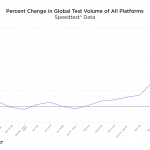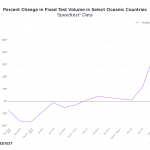Ookla has provided independent insight into how various services in Australia and overseas perform. A current and very real issue we are facing is the consistency – or lack of – from our internet service providers.
Specifically, as our workforce becomes more remote while working from home during the pandemic. That too is being tracked on their page: Tracking COVID-19’s impact on global internet performance.
It’s still early days for our migration “home” but so far, the stats show that our fixed broadband is holding up somewhat better than our mobile networks. Yesterday, we saw some fairly significant issues with multiple mobile networks, Telstra suffered particularly badly with congestion.
Users are very clearly noticing this congestion and it’s not just local. The volume of speed tests being conducted on mobile and fixed broadband services is growing day on day internationally. This was confirmed for us by Adriane Blum, Director Marketing and Communication which is backed up by their online graphing.
We have seen a record week in testing. On Monday, more tests were taken with Speedtest in a single day than any other in Ookla’s history.
That record has been easily surpassed day over day, with Tuesday beating Monday’s record and so on.
So far so good for Australia’s Fixed broadband services
While there are plenty of doubts about the capability of the NBN, perhaps even the longer-term viability the data shows that – so far at least – it seems to have held up to the extra pressure it’s under.
The data from other countries clearly shows a drop in the median download speeds as users spend more and more time at home, our fixed services haven’t deteriorated yet. This could be partly due to the bandwidth boost from NBN Co. Another influence could be thanks to the reduction in the streaming video quality offered by some services. What this does show that something is going right and users are getting a consistent service and data speed delivery.
Sadly the same can’t be said for our mobile networks data delivery with a noticeable decrease in speeds during the same period. The decrease in speeds correlates with the migration of significant numbers of workers from shared, office-based bandwidth to separate home connections and running their workday from a mobile phone. This is putting further stress on mobile networks by having users dispersed far wider than normal. Having users away from the core towers around business districts that are capable of handling the huge number of calls and data required daily.
While the speed decrease isn’t catastrophic, it does show that our usually solid and reliable 4G networks aren’t bulletproof. With that in mind, we may need to prepare ourselves for further service issues as users are requested to stay home in order to curb the spread of the Coronavirus.
In theory, having users home wouldn’t result in extra data but who doesn’t mind some music streaming or a spot of Netflix when they’re working from home?
We’re only in the starting stages of a very long road currently, we’re going to see plenty of ups and downs before this is done. If you come across any excellent customer service, great deals or other information that can help others navigate the current world situation: Tip us and we’ll share it with the Ausdroid community.








